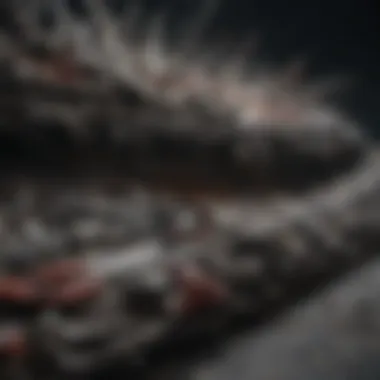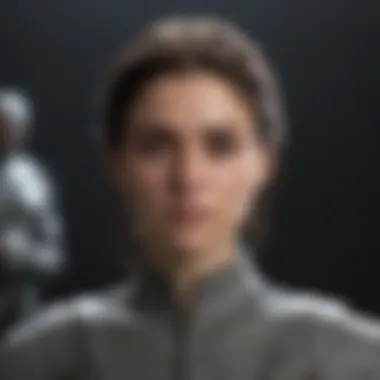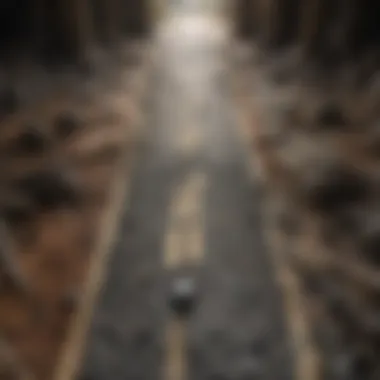Analyzing the Divergence: Game of Thrones vs. A Song of Ice and Fire


Character Dissections
As we embark on this intellectual journey exploring the differences between Game of Thrones and its literary foundation, A Song of Ice and Fire, it is imperative to begin by delving into the intricacies of character portrayals. A meticulous dissection of key personas in the series will shed light on the nuances of their development over the course of the show. By examining the evolution of characters like Daenerys Targaryen, Jon Snow, and Cersei Lannister, we can unravel how their arcs diverge from the original narrative penned by George R. R. Martin. The impact of these alterations on the overarching storyline will be scrutinized, providing a deeper understanding of the creative liberties taken in the adaptation process.
Episode Breakdowns
Transitioning seamlessly from character analysis, let us now traverse the terrain of episode breakdowns, scrutinizing significant events that transpired in each segment of the series. Through a meticulous recap of key plot points, thematic explorations, and symbolic elements interwoven within the episodes, we aim to uncover the divergences from the rich tapestry of the original source material. By dissecting pivotal moments and unraveling their implications within the context of both mediums, we can discern the narrative choices made by the show creators and their resonance with the original intent of George R. R. Martin.
Lore Explorations
Intrigued by the intricate tapestry of lore that enriches the world of Westeros, our next endeavor leads us to explore the historical and mythical depths of this vividly crafted universe. By peeling back the layers of history and culture embedded within the narrative, we seek to unearth hidden details and forge connections between the written lore and its visual interpretation. This journey into the annals of Westeros will allow us to appreciate the cultural nuances, symbolic representations, and mythical underpinnings that shape the world in both literature and on screen.
Fan Theories
Embarking on our final leg of exploration, we turn our attention to the realm of fan theories - a treasure trove of speculation and conjecture that fuels the imagination of avid enthusiasts. By curating a collection of popular and intriguing fan theories circulating within the Game of Thrones community, we aim to evaluate their credibility based on evidence from the show itself. Engaging in thoughtful speculation on future plot developments and potential twists, we seek to enrich the discourse surrounding the series and provide an enticing glimpse into the speculative landscape of this beloved epic saga.
Prelude
Overview of Game of Thrones and A Song of Ice and Fire
Game of Thrones, the highly acclaimed television series, stands as a monumental adaptation of George R. R. Martin's epic fantasy saga, A Song of Ice and Fire. The show weaves together intricate political intrigue, fantastical elements, and compelling character arcs in the richly crafted world of Westeros. A Song of Ice and Fire, the source material for the series, provides a vast tapestry of lore and narrative depth that serves as the foundation for Game of Thrones' storytelling.
Importance of Source Material in Adaptations
The role of source material in adaptations cannot be overstated. George R. R. Martin's A Song of Ice and Fire series serves as the creative genesis for Game of Thrones, setting the tone, characters, and overarching narrative structure for the televised interpretation. Through a faithful adherence or selective deviation from the source material, adaptations can either elevate or diminish the essence of the original work, influencing how audiences perceive and engage with the story's core elements.
Purpose of the Analysis
The analysis of the disparities between Game of Thrones and A Song of Ice and Fire aims to unravel the creative decisions and narrative shifts that characterize the adaptation process. By delving into the alterations made in plotlines, character portrayals, and world-building aspects, this exploration seeks to illuminate the divergences between the two mediums. Through this scrutiny, readers will gain a deeper understanding of how adaptations can reshape narratives and resonate with audiences in distinct ways.


Character Portrayal
Character portrayal holds a pivotal role in dissecting the essence of deviations between the Game of Thrones TV series and the A Song of Ice and Fire book series. It serves as a compass guiding the audience through the intricate alterations, omissions, and adaptations that define the show's narrative deviation from George R. R. Martin's original work. This section meticulously examines how each character's depiction shapes the storytelling dynamic, providing a foundation for understanding the nuances woven into the fabric of both mediums.
Key Characters
Ned Stark
Delving into the enigmatic persona of Ned Stark unravels a tapestry of honor, integrity, and moral fortitude. His unwavering commitment to justice and loyalty paints a portrait of a nobleman navigating treacherous waters, making him a linchpin character in both the series and the books. The juxtaposition of Ned Stark's rigid principles against the murky politics of the realm showcases the complexities of his character and underlines the tragic consequences of his unwavering beliefs. While his steadfast nature adds a layer of authenticity to the narrative, it also exposes the vulnerability inherent in a world driven by deceit and ambition.
Tyrion Lannister
The indomitable spirit of Tyrion Lannister casts a vibrant hue on the canvas of conflicting loyalties and personal resilience. His quick wit, strategic acumen, and emotional depth offer a refreshing counterbalance to the pervasive darkness permeating the storylines. Tyrion's ability to maneuver through the intricacies of power dynamics while preserving his humanity makes him a compelling figure in both mediums. However, his penchant for self-preservation and cynicism unveils a complexity that blurs the lines between heroism and opportunism, fostering a dynamic character arc that resonates with audiences.
Daenerys Targaryen
The evolution of Daenerys Targaryen from a vulnerable exiled princess to a formidable leader epitomizes resilience, transformation, and the quest for identity. Her journey across continents and cultures symbolizes a quest for power, freedom, and her place in a shifting world order. Daenerys' unwavering belief in her destiny, underlined by her connection to dragons and ancient legacies, infuses a mystical allure into the narrative tapestry. However, as her pursuit of the Iron Throne intensifies, cracks begin to surface in her unwavering resolve, sparking debates about the thin line between liberation and tyranny.
Character Arcs
Character arcs serve as the lifeblood of storytelling, sculpting the trajectory of individuals within the narrative landscape. They provide a roadmap for growth, transformation, and sometimes regression, offering a glimpse into the resilience or fragility of characters as they navigate the tumultuous seas of conflict and resolution. Each character arc within Game of Thrones showcases a kaleidoscope of emotions, decisions, and consequences that shape the essence of the adaptation, highlighting the fluid nature of identity and purpose within a realm defined by shifting allegiances and moral ambiguities.
Character Backstories
Peeling back the layers of character backstories unveils a trove of secrets, motivations, and traumas that breathe life into the individuals populating the world of Westeros and Essos. These intricate webs of past experiences, relationships, and choices lay the groundwork for present actions, shaping destinies and forging alliances that reverberate across generations. Understanding the origins and influences that mold characters like pieces on a chessboard adds depth and texture to the narrative, fostering empathy, intrigue, and sometimes disdain for the players in this grand game of thrones.
Plot Deviations
Plot deviations play a crucial role in this article as they highlight the key differences between the renowned 'Game of Thrones' television series and the epic 'A Song of Ice and Fire' book series penned by George R. R. Martin. By exploring plot discrepancies, we gain valuable insights into the creative choices made during the adaptation process, ultimately discerning how the narrative trajectory diverges from its source material. This analysis not only enriches our understanding of storytelling methodologies but also elucidates the impact of variance on viewer perceptions and engagement.
Major Plot Lines


-#### The Red Wedding The infamous 'Red Wedding' constitutes a pivotal juncture within both narratives, known for its brutality and unexpected twists. In the television adaptation, this event significantly deviates from its portrayal in the original books, amplifying the shock factor but potentially altering the overarching themes of betrayal and consequences. The unique blend of suspense and tragedy embodied by the 'Red Wedding' contributes to the storyline's compelling nature, evoking strong emotional responses from audiences.
-#### Dorne Plot The 'Dorne Plot' serves as another intriguing deviation within the 'Game of Thrones' series, introducing a distinct cultural backdrop and political intrigue absent in the source material. While this divergence enhances the richness of the on-screen narrative, it also raises questions about character development and coherence with the larger storyline. The inclusion of the 'Dorne Plot' showcases the adaptational liberties taken by the show creators, catering to the visual medium's requirements for dramatic tension and visual appeal.
-#### Battle of Winterfell The grandiose 'Battle of Winterfell' marks a visual spectacle in the television series, replete with intricate battle sequences and high-stakes drama. However, deviations in tactics and character arcs during this battle sequence evoke both praise and critique from audiences, showcasing a departure from the strategic depth and character nuances present in the original textual depiction. The 'Battle of Winterfell' exemplifies the show's aptitude for grandeur but also underscores the challenges of adapting complex warfare narratives for the screen.
Minor Subplots
While major plot lines seize the spotlight, minor subplots inject additional layers of intrigue and complexity into the overarching narrative fabric. These less pronounced storylines often serve to deepen character motivations, intensify thematic undercurrents, and broaden the immersive world-building efforts. By examining the minor subplots in 'Game of Thrones' vis-a-vis the source material, we gain a nuanced understanding of how adaptational choices shape the storytelling landscape, enriching the viewer's experience with nuanced subtext and thematic resonance.
World-Building Disparities
In the extensive realm of exploring the divergences between Game of Thrones and its source material, the divergence in world-building stands out as a pivotal aspect. World-building disparities play a critical role in shaping the narrative and atmosphere of any fictional universe. In this analysis, the spotlight is on dissecting how the geographical, cultural, and historical elements deviate between the television adaptation and the original books. By meticulously examining these nuances, we gain a profound insight into how alterations in world-building can profoundly influence the storytelling and audience immersion. Through a keen focus on world-building disparities, the readers embark on a journey of discovery that unveils the intricate layers of creative decision-making and their impact on narrative coherence.
Geographical Differences
Unveiling the geographical differences between the Game of Thrones series and A Song of Ice and Fire novel series unveils a tapestry of contrasting landscapes and settings. The adaptation process often necessitates compression, expansion, or reinterpretation of various locations from the source material. By delving into the geographical discrepancies, we unravel how the TV series alters the spatial layout and characteristics of key places, affecting the visual representation of the narrative world. This section meticulously dissects the transmutation of landscapes, cityscapes, and strategic locations, providing a nuanced understanding of the creative choices that shape the visual identity of the adaptation.
Cultural Variances
Amidst the exploration of disparities lies the intricate web of cultural variances that distinguish the Game of Thrones television series from its literary counterpart. Cultural elements such as customs, traditions, languages, and social hierarchies undergo subtle or drastic changes during the transformation from book to screen. By scrutinizing these cultural discrepancies, we unravel the complexities of adapting rich fictional cultures onto the visual medium. This section sheds light on how alterations in cultural nuances can influence character dynamics, plot developments, and audience engagement, amplifying the multifaceted nature of storytelling through cultural lens.
Historical Context
Diving into the depths of historical context reveals a trove of divergences embedded within the adaptation process of Game of Thrones. The historical backstory, legends, wars, and events that underpin the narrative fabric undergo reinterpretation or exclusion in the transition from book to screen. By dissecting the historical context disparities, we unearth the implications of altering crucial historical elements on character motivations, plot coherence, and audience interpretation. This section meticulously examines how deviations in historical context can shape the authenticity and resonance of the on-screen adaptation, providing a comprehensive view of the intricate interplay between past events and present storytelling.
Visual Adaptation
Visual Adaptation plays a pivotal role in this analysis of the differences between Game of Thrones and its source material. It serves as a crucial component in translating the written word into a visually captivating on-screen experience. The essence of Visual Adaptation lies in its ability to bring to life the settings, characters, and overall ambiance envisioned by the creators. By delving into the specific elements of visual adaptation, we can unravel how the choices made in terms of set designs, costume designs, and special effects contribute to shaping the world of Westeros and Essos.
Set Designs


In the realm of set designs, meticulous attention to detail is paramount. Each location, from the towering walls of King's Landing to the frigid beauty of The Wall, must be crafted with precision to reflect the richness of George R. R. Martin's universe. The considerations about set designs extend beyond mere aesthetics; they play a crucial role in setting the tone and ambiance of each scene, immersing the audience in a world that is both fantastical and believable. Through an in-depth exploration of set designs, we can appreciate how every architectural choice adds another layer of depth to the narrative.
Costume Designs
Costume designs in Game of Thrones are more than just clothing; they are a visual language that speaks to the social hierarchy, cultural nuances, and individual character traits within the series. Each fabric, color, and accessory is carefully chosen to communicate aspects of a character's personality or background. By examining costume designs closely, we can uncover hidden symbols, subtle character development cues, and the overarching thematic motifs woven into the fabric of each garment.
Special Effects
Special effects in Game of Thrones elevate the fantastical elements of the narrative to new heights. From breathtaking dragon sequences to epic battles, these visual marvels enhance the viewer's immersion in the world of Westeros. However, the true magic of special effects lies not just in their grandeur but in their ability to evoke emotion, suspense, and awe. Through a discussion of special effects, we can dissect how these visual tools are used to amplify storytelling, create memorable moments, and leave a lasting impact on the audience.
Fan Reactions
Fan reactions play a pivotal role in dissecting the nuances of how a beloved narrative transitions from book to screen. Within the realm of Game of Thrones and A Song of Ice and Fire, fan reactions serve as a barometer for the success or failure of adaptation choices. They offer a glimpse into the passionate fan base's highs and lows as they witness their cherished characters and storylines evolving on screen, scrutinizing every deviation from the source material. These reactions can range from fervent praises for faithful adaptations to vehement criticisms for diverging too far from George R. R. Martin's original vision. By delving into the spectrum of fan reactions, this article aims to provide a comprehensive understanding of the intricate relationship between creators, source material, and audience expectations.
Controversial Adaptation Choices
The landscape of film and television adaptations is fraught with the peril of controversial decisions that can make or break the reception of a beloved series. In the case of Game of Thrones' adaptation from A Song of Ice and Fire, controversial choices abound, sparking intense debates among fans and critics alike. From altering character arcs to introducing plotlines divergent from the books, the adaptation made bold decisions that sometimes veered off course from the established lore. The contentious nature of these choices stems from the delicate balance creators must strike between honoring the source material and infusing fresh perspectives to engage a broader audience. By delving into these controversial adaptation choices, this section aims to unravel the complexities of adapting a rich literary tapestry into a visual medium, examining the repercussions of creative liberties on fan reception and narrative coherence.
Critical Reception
The critical reception of adaptations serves as a mirror reflecting the convergence or dissonance between artistic interpretation and audience expectations. For Game of Thrones, critical reception encapsulates a divergent spectrum of reviews, ranging from fervent adoration to harsh critique. Critics dissect every aspect of the adaptation, from character portrayals to narrative deviations, judging the series' merit in capturing the essence of George R. R. Martin's epic saga. The critical discourse surrounding Game of Thrones not only sheds light on the show's artistic merits but also reveals the broader considerations at play when translating intricate literary works to the screen. By delving into the myriad of critical responses, this section seeks to illuminate the multi-faceted dialogue between creators, critics, and fans, unpacking the layers of interpretation and evaluation that shape our understanding of adaptation quality.
Fandom Response
Fandom response serves as the beating heart of any adaptation, dictating the legacy and longevity of a series within the pop culture zeitgeist. In the case of Game of Thrones, the fandom response reverberates with a potent mix of adulation and disillusionment, echoing the highs and lows of the show's narrative trajectory. Fans invest not only in the characters and lore but also in the fidelity of adaptation choices that honor the intricacies of Martin's world. Their response, whether through fan theories, fan fiction, or fan art, showcases the enduring impact of a beloved franchise on creative expression and communal engagement. By exploring the depths of fandom response, this section aims to provide a glimpse into the fervent passion driving fan communities, highlighting the profound influence of fan culture on the success and reception of adaptations.
Ending
In delving deep into the intricacies of the discrepancies between Game of Thrones and its source material, we unearth a profound appreciation for the complexities of adaptation. This analysis serves as a crucial lens through which we can decipher the nuanced alterations, omissions, and modifications that define the divergence of the TV series from George R. R. Martin's original books. By scrutinizing these variations, we illuminate the very essence of storytelling evolution and the artistic license inherent in adaptation processes. The significance of this exploration lies in unraveling the layers of creative interpretation that shape how narratives transition from one medium to another.
Final Thoughts
Reflecting on the extensive examination of disparities between Game of Thrones and A Song of Ice and Fire, we conclude with a deeply contemplative stance. The juxtaposition of visual storytelling against textual lore unveils a spectrum of divergent paths that challenge conventional notions of fidelity and authenticity in adaptation. Each alteration prompts a reflection on the interpretative choices that drive narrative transformation, underscoring the intricate dance between literary canon and on-screen realization. This profound exploration resonates with implications beyond mere entertainment, offering a gateway to ponder the broader implications of cultural consumption and storytelling evolution.
Impact on Future Adaptations
The profound impact of the discrepancies highlighted in this analysis extends far beyond the realms of Westeros and Essos. As we dissect the repercussions of diverging from source material, we glimpse into the future of adaptations in the cinematic landscape. The lessons gleaned from the tensions between fidelity and innovation pave the way for a new era of storytelling possibilities. By navigating the trials and triumphs of Game of Thrones' adaptation journey, we equip ourselves with insights crucial for shaping the future landscape of screen adaptations. This exploration serves as a beacon guiding upcoming creators, urging them to tread the fine line between honoring the essence of original works and imbuing them with fresh perspectives to captivate evolving audiences.



